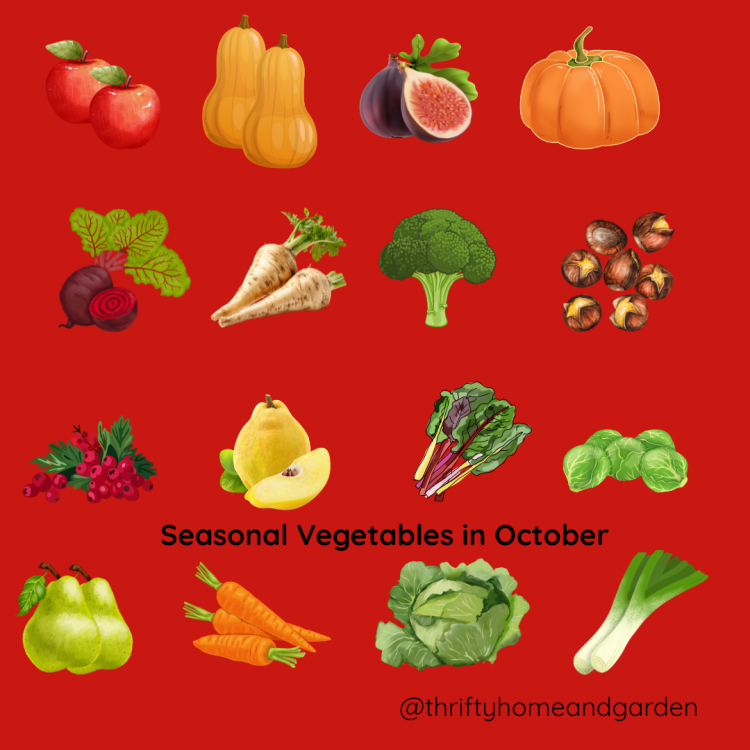As autumn settles across the British Isles, October brings forth nature’s final flourish before winter’s arrival. This month marks a pivotal time in the agricultural calendar, when orchards hang heavy with fruit and vegetable patches overflow with hearty produce that has spent months gathering strength and flavour. The crisp air and shorter days signal the perfect conditions for harvesting some of the year’s most nutritious and flavourful offerings.
October’s seasonal produce represents the culmination of months of careful cultivation, delivering ingredients that are not only at their peak nutritionally but also embody the robust, warming flavours that define British autumn cuisine. From ancient apple varieties that have graced our landscape for centuries to vibrant squashes that transform any kitchen into an artist’s palette, this month’s harvest connects us to both our culinary heritage and the natural rhythms of the seasons.
Understanding and embracing seasonal eating offers numerous benefits beyond mere flavour. Seasonal produce is typically more affordable, having travelled shorter distances and being available in greater abundance. These ingredients also provide precisely the nutrients our bodies crave as temperatures drop and daylight diminishes, offering the perfect foundation for nourishing autumn meals that sustain and comfort.
1. Apples
October stands as the crown jewel of apple season, when British orchards reach their magnificent peak. From the ancient Worcester Pearmain to the beloved Cox’s Orange Pippin, this month delivers apples with complex flavours that have developed through months of careful ripening on the tree.
Nutritional Benefits
Apples provide an excellent source of dietary fibre, particularly pectin, which supports digestive health and helps regulate blood sugar levels. Rich in vitamin C and antioxidants called flavonoids, particularly quercetin, apples support immune function precisely when seasonal changes challenge our body’s defences. The old adage “an apple a day keeps the doctor away” holds scientific merit, as regular apple consumption has been linked to reduced risk of heart disease and certain cancers.
Cooking Methods
October apples excel in both raw preparations and cooked applications. For baking, choose firm varieties like Bramley or Granny Smith that hold their shape. Cooking apples benefit from slow, gentle heat that allows their natural sugars to caramelise. Try roasting apple wedges with rosemary and thyme for a savoury twist, or simmer them with warming spices like cinnamon and star anise for traditional autumn flavours.
Storage Tips
Store apples in the refrigerator’s crisper drawer, where they can maintain quality for several weeks. Keep them separate from other produce, as apples release ethylene gas that can accelerate ripening in nearby fruits and vegetables. For long-term storage, wrap individual apples in newspaper and store in a cool, dark place with good ventilation.
Recipe Ideas
Create a classic apple crumble using mixed varieties for complexity, or prepare a French-style tarte tatin that showcases the fruit’s natural sweetness. Apple and cheddar soup offers an unexpectedly delightful combination, whilst roasted apple and butternut squash soup captures October’s essence perfectly.
2. Pears
October pears arrive with their characteristic buttery texture and delicate sweetness fully developed. British Conference pears reach their prime this month, offering flesh that melts on the tongue and a fragrance that perfumes the entire kitchen.
Nutritional Benefits
Pears provide exceptional amounts of dietary fibre, with one medium pear containing approximately 6 grams—nearly a quarter of the daily recommended intake. They’re rich in vitamin K, essential for bone health, and copper, which aids in iron absorption. Pears also contain significant amounts of vitamin C and potassium, supporting cardiovascular health and immune function.
Cooking Methods
Pears require gentle handling due to their tender nature when ripe. Poaching in wine or spiced syrups allows their flavours to intensify whilst maintaining their elegant shape. For baking, choose slightly underripe pears that will soften during cooking without becoming mushy. Grilling pear halves brings out their natural sugars and creates beautiful caramelisation.
Storage Tips
Pears ripen from the inside out, so check for ripeness by gently pressing near the stem—it should yield slightly. Store unripe pears at room temperature to encourage ripening, then refrigerate once they reach desired ripeness. Unlike apples, pears don’t store well for extended periods, so enjoy them within a week of ripening.
Recipe Ideas
Poached pears in red wine with cinnamon and cardamom create an elegant dessert, whilst pear and gorgonzola tart offers a sophisticated flavour combination. Try roasting pears with honey and thyme, or incorporate them into a warming pear and parsnip soup for an unexpectedly delightful starter.
3. Pumpkins and Squashes
October marks the spectacular arrival of the squash family, painting markets and gardens with their vibrant oranges, deep greens and creamy yellows. From the mighty pumpkin to the delicate butternut squash, these versatile vegetables represent autumn’s most iconic produce.
Nutritional Benefits
Pumpkins and squashes burst with beta-carotene, which the body converts to vitamin A—essential for eye health, immune function, and skin maintenance. They’re also excellent sources of vitamin C, potassium, and manganese. The bright orange flesh indicates high levels of carotenoids, powerful antioxidants that may help reduce inflammation and support heart health.
Cooking Methods
Roasting brings out the natural sweetness in all squash varieties, caramelising their edges whilst maintaining a creamy interior. Cut pumpkins and squashes into uniform pieces for even cooking, and don’t forget that the skin of many varieties, particularly butternut squash, becomes tender and edible when roasted. Steaming works well for purees, whilst grilling adds a lovely smoky flavour.
Storage Tips
Whole pumpkins and winter squashes store exceptionally well in cool, dry conditions with good air circulation. They can last several months when stored properly. Once cut, wrap pieces tightly and refrigerate for up to a week or freeze puree for longer storage.
Recipe Ideas
Create a velvet-smooth pumpkin soup with coconut milk and warming spices, or try roasted squash risotto with sage and parmesan. Pumpkin bread and butternut squash gnocchi showcase their versatility, whilst roasted squash seeds make a nutritious snack seasoned with herbs and spices.
4. Brussels Sprouts
Often misunderstood and underappreciated, Brussels sprouts reach their flavourful peak in October when cool temperatures have concentrated their natural sugars and reduced any bitterness. These miniature cabbages deserve a place of honour on autumn tables.
Nutritional Benefits
Brussels sprouts rank among the most nutritionally dense vegetables available, providing exceptional amounts of vitamins K and C, folate, and manganese. They’re particularly rich in glucosinolates, sulfur compounds that may have cancer-protective properties. The high fibre content supports digestive health, whilst their antioxidant profile helps combat inflammation.
Cooking Methods
The key to delicious Brussels sprouts lies in proper preparation and cooking technique. Trim the stem end and remove any damaged outer leaves, then cut in half to ensure even cooking. Roasting at high heat creates crispy, caramelised edges whilst maintaining tender centers. Blanching followed by sautéing offers another excellent approach, preserving their vibrant colour and slight crunch.
Storage Tips
Store Brussels sprouts in the refrigerator’s crisper drawer, preferably still attached to their stalk if available. Loose sprouts should be kept in a perforated plastic bag and used within a week. Avoid washing until ready to use, as excess moisture can lead to premature deterioration.
Recipe Ideas
Try shredded Brussels sprouts salad with dried cranberries and toasted almonds, or roast them with bacon and chestnuts for a classic autumn combination. Brussels sprouts gratin with cream and gruyere transforms this humble vegetable into an elegant side dish.
5. Parsnips
October signals the beginning of parsnip season, when the first frosts have converted their starches to sugars, creating the sweet, nutty flavour that makes this root vegetable so beloved in British cuisine. These cream-coloured roots offer earthy sophistication to autumn meals.
Nutritional Benefits
Parsnips provide substantial amounts of dietary fibre, folate, and vitamin C. They’re also a good source of potassium and manganese, supporting heart health and bone formation respectively. The high fibre content aids digestive health and helps maintain stable blood sugar levels, making parsnips an excellent choice for sustained energy.
Cooking Methods
Roasting remains the most popular method for preparing parsnips, as the high heat caramelises their natural sugars and creates crispy edges. Cut into uniform batons for even cooking, and toss with herbs like rosemary or thyme. Parsnips also excel in soups and purees, where their natural sweetness balances savoury elements beautifully.
Storage Tips
Store parsnips in the refrigerator’s crisper drawer, where they’ll maintain quality for several weeks. Remove any green tops before storage, as these can draw moisture from the roots. Avoid storing near ethylene-producing fruits like apples, which can cause bitter flavours to develop.
Recipe Ideas
Honey-glazed roasted parsnips with fresh herbs make an elegant side dish, whilst parsnip and apple soup offers a delightful flavour combination. Try parsnip crisps as a healthy snack alternative, or incorporate them into a root vegetable gratin for a satisfying autumn dish.
6. Leeks
October leeks have spent months developing their mild, sweet onion flavour and tender texture. These elegant alliums represent one of Britain’s most versatile vegetables, equally at home in rustic soups and refined preparations.
Nutritional Benefits
Leeks provide excellent amounts of vitamin K, essential for blood clotting and bone health. They’re also rich in folate, manganese, and vitamin A. Like other alliums, leeks contain sulfur compounds that may have antimicrobial properties and support cardiovascular health. Their prebiotic fibres promote beneficial gut bacteria growth.
Cooking Methods
Leeks require thorough cleaning due to soil trapped between their layers. Slice lengthwise and rinse under cold water, separating the layers to remove all grit. The white and light green portions are typically used for cooking, though tender green parts add flavour to stocks. Braising, sautéing, and grilling all work beautifully with leeks.
Storage Tips
Store leeks in the refrigerator’s crisper drawer, wrapped in plastic to prevent them from drying out. They’ll maintain quality for up to two weeks when stored properly. Avoid storing near strong-smelling foods, as leeks can absorb odours.
Recipe Ideas
Classic leek and potato soup showcases their gentle flavour, whilst braised leeks with white wine and herbs make an elegant side dish. Try leek and gruyere tart for a sophisticated lunch, or incorporate them into a warming chicken and leek pie for comfort food at its finest.
7. Carrots
October carrots have reached perfect maturity, their natural sugars concentrated through months of steady growth. These vibrant orange roots offer both nutritional density and culinary versatility that makes them indispensable in autumn cooking.
Nutritional Benefits
Carrots are renowned for their exceptional beta-carotene content, with just one medium carrot providing more than 100% of the daily vitamin A requirement. They also provide fibre, potassium, and antioxidants including lutein and zeaxanthin, which support eye health. The natural sugars in carrots provide quick energy whilst their fibre helps maintain steady blood sugar levels.
Cooking Methods
October carrots shine whether prepared simply or in complex dishes. Roasting concentrates their sweetness and creates beautiful caramelisation, whilst steaming preserves their delicate texture and bright colour. Young carrots can be enjoyed raw, their natural sweetness perfect for salads and crudité platters.
Storage Tips
Remove green tops before storing, as these draw moisture from the roots. Store carrots in the refrigerator’s crisper drawer in a perforated plastic bag, where they’ll maintain quality for several weeks. Avoid storing near apples or other ethylene-producing fruits.
Recipe Ideas
Honey-roasted carrots with thyme create a perfect side dish, whilst carrot and coriander soup offers warming comfort. Try carrot ribbon salad with lemon vinaigrette for a fresh preparation, or incorporate them into a hearty beef and carrot stew for ultimate autumn satisfaction.
8. Beetroot
October beetroot reaches its prime, offering deep, earthy flavours and stunning colours that range from traditional deep red to golden yellow and candy-striped varieties. These nutrient-dense roots deserve recognition beyond their pickled preparations.
Nutritional Benefits
Beetroot contains unique compounds called betalains, which provide its distinctive colour and possess powerful antioxidant and anti-inflammatory properties. Rich in folate, manganese, and nitrates, beetroot may support cardiovascular health and exercise performance. The natural nitrates convert to nitric oxide in the body, potentially improving blood flow and reducing blood pressure.
Cooking Methods
Roasting beetroot whole in foil preserves its moisture whilst concentrating flavours. The skin slips off easily after cooking, revealing tender, intensely flavoured flesh beneath. Raw beetroot can be grated for salads, offering a fresh, slightly peppery taste that contrasts beautifully with creamy ingredients.
Storage Tips
Store beetroot with tops removed in the refrigerator’s crisper drawer, where they’ll maintain quality for several weeks. The leafy tops are edible and nutritious—use them within a few days like spinach or chard. Cooked beetroot stores well refrigerated for up to a week.
Recipe Ideas
Roasted beetroot and goat cheese salad with walnuts creates an elegant starter, whilst beetroot risotto offers dramatic colour and earthy flavour. Try beetroot and chocolate brownies for an unexpectedly delicious dessert, or prepare a warming beetroot and apple soup for autumn comfort.
9. Cabbage
October cabbage varieties offer exceptional quality, their heads firm and dense with concentrated flavours developed through cool autumn weather. From traditional white and red varieties to the elegant savoy cabbage with its crinkled leaves, this versatile brassica deserves renewed appreciation.
Nutritional Benefits
Cabbage provides outstanding amounts of vitamin C and vitamin K, supporting immune function and bone health respectively. Rich in glucosinolates and other sulfur compounds, cabbage may offer protective benefits against certain cancers. The high fibre content promotes digestive health, whilst its low calorie density makes it valuable for weight management.
Cooking Methods
Raw cabbage offers crisp texture and peppery flavour perfect for slaws and salads. Cooking transforms its character completely—braising creates tender, sweet results whilst stir-frying maintains some crunch. Red cabbage benefits from longer, slower cooking with acidic ingredients like vinegar or wine, which preserve its vibrant colour.
Storage Tips
Store whole heads of cabbage in the refrigerator, where they can maintain quality for several weeks. Once cut, wrap tightly and use within a week. Avoid storing near ethylene-producing fruits, which can cause premature deterioration and strong odours.
Recipe Ideas
Traditional coleslaw showcases raw cabbage’s crisp texture, whilst braised red cabbage with apples and cinnamon creates a perfect autumn side dish. Try stuffed cabbage leaves with rice and herbs, or prepare a hearty cabbage and sausage soup for warming comfort food.
10. Chestnuts
October heralds the arrival of chestnuts, those glossy brown nuts that have graced British tables since medieval times. Street vendors roasting chestnuts over glowing coals represent one of autumn’s most evocative aromas and traditions.
Nutritional Benefits
Unlike other nuts, chestnuts are relatively low in fat but rich in complex carbohydrates, making them more similar to grains nutritionally. They provide substantial amounts of vitamin C, folate, and manganese, along with beneficial minerals like potassium and magnesium. Their starchy nature provides sustained energy, whilst their natural sweetness satisfies cravings without added sugars.
Cooking Methods
Roasting remains the classic preparation method—score an X on the flat side of each chestnut to prevent bursting, then roast in a hot oven until the shells split and the flesh becomes tender. Boiling or steaming works well for chestnuts destined for purees or stuffings. Properly cooked chestnuts should be fluffy and sweet, with no bitter aftertaste.
Storage Tips
Fresh chestnuts should feel heavy for their size and show no signs of mold or insect damage. Store them in the refrigerator in a perforated plastic bag for up to a week, or freeze for longer storage. Cooked chestnuts can be refrigerated for several days or frozen for future use.
Recipe Ideas
Chestnut soup with pancetta and herbs creates elegant autumn dining, whilst chestnut stuffing enhances holiday meals beautifully. Try chestnut and mushroom risotto for sophisticated comfort food, or prepare candied chestnuts for a traditional sweet treat that captures autumn’s essence perfectly.
Embracing October’s Natural Abundance
October’s seasonal produce represents far more than mere ingredients—these foods connect us to the natural world’s rhythms and our culinary heritage. Each vegetable and fruit arriving at its peak this month has been shaped by centuries of cultivation and selection, resulting in varieties perfectly adapted to British growing conditions and autumn harvests.
The nutritional profiles of October’s produce align remarkably well with our body’s changing needs as daylight diminishes and temperatures drop. The high vitamin C content in apples, Brussels sprouts and chestnuts supports immune function precisely when seasonal changes challenge our defences. The complex carbohydrates in squashes and parsnips provide sustained energy for shorter, cooler days, whilst the warming spices that complement these ingredients—cinnamon, nutmeg and ginger—have been used for centuries to support circulation and digestion during autumn months.
Cooking with seasonal produce also connects us to sustainable practices that support local agriculture and reduce environmental impact. These ingredients require minimal transportation and storage, arriving at markets with optimal freshness and nutritional density. The natural preservation methods our ancestors developed—root cellaring, drying, and fermentation—remain relevant today, allowing us to extend autumn’s bounty throughout the winter months.
The flavours of October produce tell the story of the season itself. The gentle sweetness of pears and apples, the robust earthiness of root vegetables, and the warming spices that complement them all create a culinary palette that mirrors the changing landscape outside our windows. These ingredients invite us to slow down, to savour the process of cooking, and to appreciate the remarkable transformation that occurs when simple, seasonal ingredients are treated with respect and creativity.
As you explore October’s magnificent harvest, remember that each ingredient carries within it the accumulated wisdom of generations of growers, cooks and food lovers. From the ancient apple varieties that have survived centuries of changing tastes to the humble Brussels sprout that has recently enjoyed a renaissance in modern kitchens, these foods connect us to our past whilst nourishing our future.
Further Reading: October Foraging: Nature’s Autumn Harvest, Winter Comfort Food – Casseroles and Stews, English Pudding Season,







